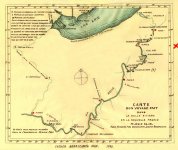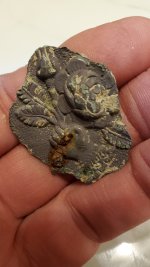FRENCHMEN'S GOLD (Coudersport, Potter County)
FRENCHMEN'S GOLD (Coudersport, Potter County) Ah, another legend of lost gold. Late in the 1690s, a group of French Canadians and Jesuits, led by Louis Frontenac, left New Orleans for Montreal. They sailed up the Mississippi to the Ohio, past what is now Pittsburgh and up the Allegheny. Their rafts were loaded with kegs filled with gold coins, worth $350,000 today, destined for the Royal Governor of Canada's treasury. After reaching present-day Potter County, they started overland, hoping to reach the Gennesee River and a straight shot to Montreal, but the heavy coins made the going slow. Fearing an Indian attack (the Senecas were long time enemies of the French), they decided to bury the booty just north of present-day Coudersport. They marked the spot with a cross chipped onto a large rock. The Senecas are said to have seen the marking, but left it alone because they feared the religious significance. In time, the marker eroded and the site was forgotten. The Frenchmen made it home, but never returned for their gold and to this day it's still buried.
FRENCHMEN'S GOLD (Coudersport, Potter County) Ah, another legend of lost gold. Late in the 1690s, a group of French Canadians and Jesuits, led by Louis Frontenac, left New Orleans for Montreal. They sailed up the Mississippi to the Ohio, past what is now Pittsburgh and up the Allegheny. Their rafts were loaded with kegs filled with gold coins, worth $350,000 today, destined for the Royal Governor of Canada's treasury. After reaching present-day Potter County, they started overland, hoping to reach the Gennesee River and a straight shot to Montreal, but the heavy coins made the going slow. Fearing an Indian attack (the Senecas were long time enemies of the French), they decided to bury the booty just north of present-day Coudersport. They marked the spot with a cross chipped onto a large rock. The Senecas are said to have seen the marking, but left it alone because they feared the religious significance. In time, the marker eroded and the site was forgotten. The Frenchmen made it home, but never returned for their gold and to this day it's still buried.







